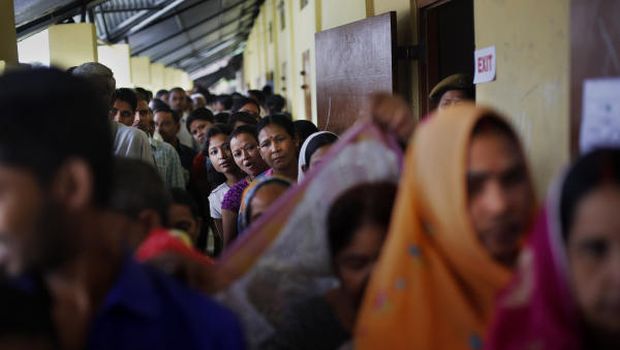
Indian voters wait in queues to cast their votes during the first phase of elections in Dibrugarh, in the northeastern state of Assam, India, on Monday, April 7, 2014. (AP Photo/Altaf Qadri)
Gauhati, AP—India started the world’s largest election on Monday, with voters in the remote northeast making their way past lush rice paddies and over rickety bamboo bridges to reach the polls. Most parties were campaigning on promises of economic growth.
The country’s 814 million electorate will vote in stages over the next five weeks—a staggered approach made necessary by India’s vast size—to choose representatives to its 543-seat lower house of parliament.
The main Hindu nationalist opposition Bharatiya Janata Party led by prime ministerial hopeful Narendra Modi is seen as the biggest threat to the now-governing Congress Party and its allies.
Results from all 935,000 polling stations are expected on May 16.
Polls suggest Congress could face a drubbing thanks to corruption scandals and recent years of economic slowdown. The BJP, which has pledged economic renewal, is expected to do well but to fall short of a 272-seat majority. Its chief, Modi, has been credited for ushering in strong industrial growth in the western state of Gujarat, where he has been chief minister for 11 years.
However, critics question whether the Hindu nationalist chief can be a truly secular leader, noting he has failed to take responsibility or apologize for communal rioting that left more than 1,000 dead in his state in 2002. He’s accused of doing little to stop the anti-Muslim rampage, though he denies any wrongdoing and has never been charged with a crime.
The BJP was the last major party on Monday to release its campaign manifesto, which envisions India’s path toward full development through “futuristic” infrastructure projects such as high-speed trains, 100 new modern cities and wireless Internet facilities in public places.
But such ambitious plans hold little appeal for most voters in rural Assam, where voting took place Monday in five constituencies as well as in one in neighboring Tripura state.
Here, people are more concerned about basic needs like guarding against the dangers of flooding, soil erosion and heavy rains washing away homes, or building more roads and bridges to connect far-away towns and villages to the main cities.
“I’ve made it a point to vote this time because we want change,” said 36-year-old housewife Rumi Nath, waiting to vote in the rural town of Lakhimpur on the Brahmaputra River. “Our area remains backward and underdeveloped 67 years after independence.”
Several of the 8,000 polling stations were temporarily closed while officials fixed or replaced faulting voting machines.
Basic survival was uppermost on the mind of another Lakhimpur voter, Pulok Nath.
“As monsoon sets in, we get worried about our daily meals,” he said. “We have been living on a mud embankment for years now after floods washed away our home and large part of our village,” Despite the common last name he was no relation to Rumi Nath.
Both Congress and BJP were hoping for a strong showing in the seven northeast states nicknamed the “Seven Sisters”—occupying a remote region nestled between Bhutan, Bangladesh and Burma and made up of diverse ethnicities. Gains for Congress among the 25 seats in the northeast would help that part offset expected losses elsewhere in India, while the BJP wants to seize one of Congress’ traditional strongholds.
Assam’s highest elected official, Chief Minister Tarun Gogoi of the Congress Party, said he was confident of winning re-election.
“There is no Narendra Modi magic in Assam. The Congress has been winning every form of elections since 2001 in Assam, and we are going to repeat the performance this time,” Gogoi said.
In the last general elections in 2009, Congress won seven of Assam’s 14 parliamentary seats to the BJP’s four, while regional parties won the rest.
Gogoi’s 32-year-old son, running for office for his first time, said he was encouraged by the large number of politically engaged youths. With more than 65 percent of the country’s 1.2 billion population aged under 35, many are expecting young voters to have a strong impact on the election.
“I am extremely happy with the enthusiasm shown by the large number of young voters who have turned out to vote this time,” Gaurav Gogoi said.
Several groups of separatist ethnic or Maoist rebels have threatened violence during the vote.
Authorities deployed 25,000 police and paramilitary troopers to guard polling stations on Monday. Helicopters were put on standby, and international borders with Bangladesh and Bhutan were sealed.
“We are not taking chances,” said A.P. Raut, Assam’s police assistant director-general.
Assam has experienced several separatist insurrections since 1979, when the rebel United Liberation Front of Asom, or ULFA, was formed. Though one ULFA faction is in peace talks with the central government, another is still engaged in roadside bombings and ambushes on government soldiers.
Other ethnic rebel groups like the National Democratic Front of Bodoland are also cause for worry, with one faction threatening northern Assam politicians.
The northeast could also be affected by rebels inspired by Chinese revolutionary leader Mao Zedong, who have called for an election boycott and threatened to disrupt the vote. The Maoist rebels are active in 20 of India’s 28 states.
Assam and Tripura will both hold polling later in April for the rest of their constituencies.
On Thursday, the vote moves to five other northeast states—Nagaland, Mizoram, Manipur, Meghalaya and Arunachal Pradesh.
